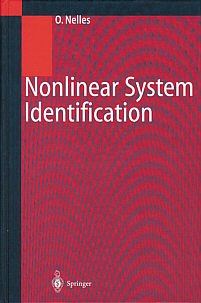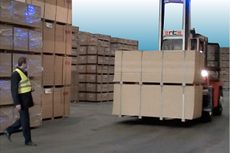Misją Instytutu jest dzialalność naukowo-badawcza prowadząca do nowych rozwiązań technicznych i organizacyjnych użytecznych w kształtowaniu warunków pracy zgodnych z zasadami bezpieczeństwa pracy i ergonomii oraz ustalanie podstaw naukowych do właściwego ukierunkowywania polityki społeczno-ekonomicznej państwa w tym zakresie.

Springer-Verlag, Berlin, Heidelberg, Germany, 2001!!
|
| 1. Introduction (1) |
| 1.1. Relevance of Nonlinear System Identification (1) |
| 1.2. Tasks in Nonlinear System Identification (6) |
| 1.3. White Box, Black Box, and Gray Box Models (15) |
| 1.4. Outline of the Book and Some Reading Suggestions (16) |
| 1.5. Terminology (18) |
| Part I. Optimization Techniques |
| 2. Introduction to Optimization (23) |
| 2.1. Overview of Optimization Techniques (25) |
| 2.2. Kangaroos (25) |
| 2.3. Loss Functions for Supervised Methods (28) |
| 2.4. Loss Functions for Unsupervised Methods (34) |
| 3. Linear Optimization (35) |
| 3.1. Least Squares (LS) (36) |
| 3.2. Recursive Least Squares (RLS) (60) |
| 3.3. Linear Optimization with Inequality Constraints (66) |
| 3.4. Subset Selection (67) |
| 3.5. Summary (77) |
| 4. Nonlinear Local Optimization (79) |
| 4.1. Batch and Sample Adaptation (81) |
| 4.2. Initial Parameters (83) |
| 4.3. Direct Search Algorithms (86) |
| 4.4. General Gradient-Based Algorithms (90) |
| 4.5. Nonlinear Least Squares Problems (102) |
| 4.6. Constrained Nonlinear Optimization (107) |
| 4.7. Summary (110) |
| 5. Nonlinear Global Optimization (113) |
| 5.1.Simulated Annealing (SA) (116) |
| 5.2. Evolutionary Algorithms (EA) (120) |
| 5.3. Branch and Bound (B&B) (133) |
| 5.4. Tabu Search (TS) (135) |
| 5.5. Summary (135) |
| 6. Unsupervised Learning Techniques (137) |
| 6.1. Principal Component Analysis (PCA) (139) |
| 6.2. Clustering Techniques (142) |
| 6.3. Summary (155) |
| 7. Model Complexity Optimization (157) |
| 7.1. Introduction (157) |
| 7.2. Bias/Variance Tradeoff (158) |
| 7.3. Evaluating the Error and Alternatives (167) |
| 7.4. Explicit Structure Optimization (176) |
| 7.5. Regularzation: Implicit Structure Optimization (179) |
| 7.6. Structured Models for Complexity Reduction (189) |
| 7.7. Summary (200) |
| 8. Summary of Part I (203) |
| Part II. Static Models |
| 9. Introduction to Static Models (209) |
| 9.1. Multivariable Systems (209) |
| 9.2. Basis Function Formulation (210) |
| 9.3. Extended Basis Function Formulation (215) |
| 9.4. Static Test Process (216) |
| 9.5. Evaluation Criteria (216) |
| 10. Linear, Polynomial, and Look-Up Table Models (219) |
| 10.1. Linear Models (219) |
| 10.2. Polynomial Models (221) |
| 10.3. Look-Up Table Models (224) |
| 10.4. Summary (237) |
| 11. Neural Networks (239) |
| 11.1. Construction Mechanisms (242) |
| 11.2. Multilayer Perceptron (MLP) Network (246) |
| 11.3. Radial Function (RBF) Networks (264) |
| 11.4. Other Neural Networks (286) |
| 11.5. Summary (296) |
| 12. Fuzzy and Neuro-Fuzzy Models (299) |
| 12.1. Fuzzy Logic (299) |
| 12.2. Types of Fuzzy Systems (304) |
| 12.3. Neuro-Fuzzy (NF) Networks (310) |
| 12.4. Neuro-Fuzzy Learning Schemes (323) |
| 12.5. Summary (339) |
| 13. Local Linear Neuro-Fuzzy Models: Fundamentals (341) |
| 13.1. Basic Ideas (342) |
| 13.2. Parameter Optimization of the Rule Consequents (351) |
| 13.3. Structure Optimization of the Rule Premises (362) |
| 13.4. Summary (389) |
| 14. Local Linear Neuro-Fuzzy Models: Advanced Aspects (391) |
| 14.1. Different Input Spaces (391) |
| 14.2. More Complex Local Models (397) |
| 14.3. Structure Optimization of the Rule Consequents (404) |
| 14.4. Interpolation and Extrapolation Behavior (408) |
| 14.5. Global and Local Linearization (416) |
| 14.6. Online Learning (420) |
| 14.7. Errorbars and Design of Excitation Signals (430) |
| 14.8. Hinging Hyperplanes (437) |
| 14.9. Summary and Conclusions (444) |
| 15. Summary of Part II (451) |
| Part III. Dynamic Models |
| 16. Linear Dynamic System Identification (457) |
| 16.1. Overview of Linear System Identification (458) |
| 16.2. Excitation Signals (459) |
| 16.3. General Model Structure (462) |
| 16.4. Time Series Models (478) |
| 16.5. Models with Output Feedback (482) |
| 16.6. Models without Output Feedback (509) |
| 16.7. Some Advanced Aspects (524) |
| 16.8. Recursive Algorithms (531) |
| 16.9. Determination of Dynamic Orders (536) |
| 16.10. Multivariable Systems (537) |
| 16.11. Closed-Loop Identification (541) |
| 16.12. Summary (546) |
| 17. Nonlinear Dynamic System Identification (547) |
| 17.1. From Linear to Nonlinear System Identification (547) |
| 17.2. External Dynamics (549) |
| 17.3. Internal Dynamics (563) |
| 17.4. Parameter Scheduling Approach (564) |
| 17.5. Training Recurrent Structures (564) |
| 17.6. Multivariable Systems (568) |
| 17.7. Excitation Signals (569) |
| 17.8. Determination of Dynamic Orders (574) |
| 17.9. Summary (576) |
| 18. Classical Polynomial Approaches (579) |
| 18.1. Properties of Dynamic Polynomial Models (580) |
| 18.2. Kolmogorov-Gabor Polynomial Models (581) |
| 18.3. Volterra-Series Models (582) |
| 18.4. Parametric Volterra-Series Models (538) |
| 18.5. NDE Models (583) |
| 18.6. Hammerstein Models (584) |
| 18.7. Wiener Models (585) |
| 19. Dynamic Neural and Fuzzy Models (587) |
| 19.1. Curse of Dimensionality (587) |
| 19.2. Interpolation and Extrapolation Behavior (589) |
| 19.3. Training (591) |
| 19.4. Integration of a Linear Model (593) |
| 19.5. Simulation Examples (594) |
| 19.6. Summary (600) |
| 20. Dynamic Local Linear Neuro-Fuzzy Models (601) |
| 20.1. One-Step Prediction Error Versus Simulation Error (604) |
| 20.2. Determination of the Premises (606) |
| 20.3. Linerization (608) |
| 20.4. Model Stability (613) |
| 20.5. Dynamic LOLIMOT Simulation Studies (618) |
| 20.6. Advanced Local Linear Methods and Models (626) |
| 20.7. Local Linear Orthonormal Basis Functions Models (631) |
| 20.8. Structure Optimization of the Rule Consequents (636) |
| 20.9. Summary and Conclusions (640) |
| 21. Neural Networks with Internal Dynamics (645) |
| 21.1. Fully Recurrent Networks (645) |
| 21.2. Partially Recurrent Networks (646) |
| 21.3. State Recurrent Networks (647) |
| 21.4. Locally Recurrent Globally Feedforward Networks (648) |
| 21.5. Internal Versus External Dynamics (650) |
| Part IV. Applications |
| 22. Applications of Static Models (655) |
| 22.1. Driving Cycle (655) |
| 22.2. Modeling and Optimization of Combustion Engine Exhaust (659) |
| 22.3. Summary (674) |
| 23. Applications of Dynamic Models (677) |
| 23.1. Cooling Blast (677) |
| 23.2. Diesel Engine Turbocharger (683) |
| 23.3. Thermal Plant (691) |
| 23.4. Summary (707) |
| 24. Applications of Advanced Methods (709) |
| 24.1. Nonlinear Model Predictive Control (709) |
| 24.2. Online Adaptation (713) |
| 24.3. Fault Detection (723) |
| 24.4. Fault Diagnosis (729) |
| 24.5. Reconfiguration (732) |
| A. Vectors and Matrices (735) |
| A.1. Vectors and Matrices Derivatives (735) |
| A.2. Gradient, Hessian, and Jacobian (737) |
| B. Statistics (739) |
| B.1. Deterministic and Random Variables (739) |
| B.2. Probability Density Function (pdf) (741) |
| B.3. Stochastic Processes and Ergodicity (743) |
| B.4. Expectation (745) |
| B.5. Variance (748) |
| B.6. Correlation and Covariance (749) |
| B.7. Properties of Estimators (753) |
| References (757) |
| Index (779) |
© 2002-2004 Centralny Instytut Ochrony Pracy - Państwowy Instytut Badawczy www.anc.pl, www.ciop.pl





